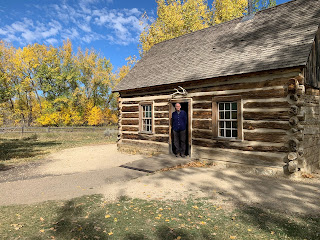Judy. As much as I love being in the mountains, my heart always longs for the beach. We've spent time at several beaches around the world, and a plan had been to spend three months in Malaga, Spain, but obviously that didn't happen, so Ted located a townhouse on St. Simons Island, which is part of Georgia's "Golden Isles," just off the Atlantic coast. We'd spent time there years ago, and weather looked good for October, so we went for it.
 |
| Sunrise |
 |
| A container ship glides by the beach |
It has been a joy. While I can spend hours reading on a beach, Ted is more interested in history and nature. St. Simons fit both of those categories. We usually walk on the beach in the morning, but a few times have wandered to historic spots like the Bloody Marsh monument. Our front windows look out on the marsh, where we can watch ibis, herons, marsh hens and kingfishers. Five minutes out the back door takes us through the sea oats to the wide beach, where the Tricolor Heron, a new bird for me, searches for food in the tide pools and pelicans, sandpipers, plovers, and seagulls patrol the ocean for their favorite morsels. Ships sail by periodically--mostly container ships--and on days when the ocean is fierce, dolphins patrol for food.
Savannah, Georgia, established in 1733, was the first settlement on the mainland, but Fort Frederica was built three years later on the north part of St Simons island to defend the area from the Spanish. An entire town grew up, populated by English debtors and their families as a way to avoid prison. After the Battle of Bloody Marsh, the town wasn't necessary any more, and by 1748, it was abandoned.
 |
| Reconstructed Armory at Ft. Frederica |
 |
| Wesley garden |
Everywhere are live oaks, dripping with Spanish moss. The entrance to Sea Island Golf Club hosts the Avenue of Oaks, once the entrance to a plantation. Avenue of Oaks
 |
| Leslie and Caed found a Tree Spirit! |
Seven of the thousands of oaks are carved with "Tree Spirits," and searching for them is a great way to spend an afternoon.
The iconic lighthouse, built in 1872 to replace an earlier one, still flashes its light at night, warning ships coming through the sound.
Meanwhile, history is being made here, as a year ago, a cargo ship filled with cars wrecked off the sound between Jekyll Island and St. Simons, and has remained an eyesore while engineers determine how to get it out. This week, early one morning, a giant structure arrived with a massive saw to cut the wreck into pieces. A huge net will catch the cars as they tumble out. Sounds like science fiction, and the entire island seemed to be out lining the shore and the pier of the village to watch.
 |
| A giant crane is moved into place to cut up the shipwreck |
Our townhouse has three floors and three bedrooms, so our daughter Leslie and her family came for a few days. Most of those days were spent on the beach, but Leslie, our grandson Caed, and I went on a scavenger hunt for the Tree Spirits. Her husband Daniel cooked up shrimp feasts for us, and one morning Ted took Caed to a "flotsam and jetsam tree" down the beach to hang a toy car we found buried in the sand. Other times, Daniel and Caed practically lived in the surf!
 |
| Adding to the flotsam and jetsam tree |
In just a few days we'll be back in Athens for a three-month--or possibly more--stint. Urban walks will replace our Western hikes and Southern beach walks. That's just fine. Being close to family is as much a treat as travel. But we sure have had fun.
 |
| A foggy morning on the beach |






























